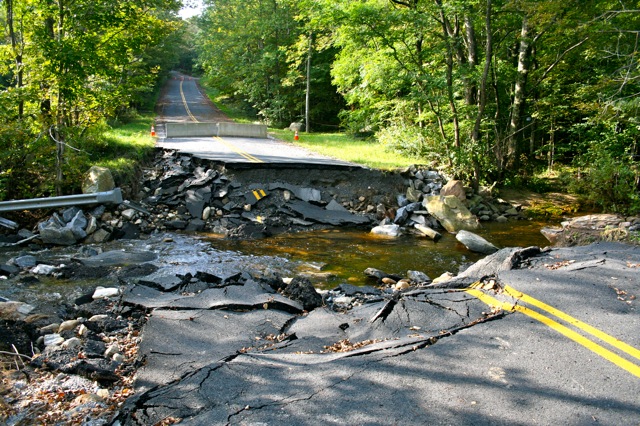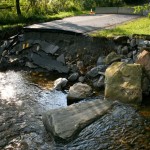
VICTORY! BEAT Gets State To Update Its Stormwater Calculations

Photo: Carrie Banks, MA Division of Ecological Restoration, Bonny Rigg Hill Road "over" Walker Brook in Becket
Our climate is changing. There really isn’t any debate in the scientific community anymore. The scientific community has moved on to solving the problem of what do we do about climate change. One thing we can do is change our preparedness for more intense storms and heavier rainfall. Most of the country has been doing this. Forty-eight states have updated their formulas used to calculate the amount of water that can be expected to flow in streams and rivers during typical and atypical storms. Rhode Island has been working on updating their calculations so that they can become the 49th state. That leaves Massachusetts as the only state not updating its stormwater calculations.
These calculations are used to predict the amount of floodwater a community can expect during an x-year storm (e.g., 50-year storm, 100-year storm, 500-year storm). This can help determine such things as how big a culvert under a road needs to be in order to keep that road from washing out during a storm. Well, Massachusetts has joined the fold, and has started taking steps to become the 50th state to update its stormwater calculations, and if we do say so ourselves, BEAT was the driving force in getting the state to act.
For quite some time BEAT has been asking Massachusetts state agencies to update the state’s 100-year flood calculations. Then in September 2011, the state released its Massachusetts Climate Change Adaptation Report . On page 19 the report states, “By 2050, Boston could experience the current 100-year riverine flood every two to three years on average and, by 2100, the current 100-year riverine flood is expected to occur every one to two years under both the low- and high-emissions scenarios.” Clearly the state recognized that the current 100-year flood, has been occurring much more frequently than its title would suggest. Our climate was changing, but the design of our culverts, bridges, and other infrastructure components were not. When developers came into meetings with plans, they still used the outdated equations for how much rain falls in how many hours to produce the x-year storm – which would result in the x-year flood.
In September, BEAT contacted the United States Geological Survey to say that BEAT was frustrated by planners’ and engineers’ use of the x-year storm as a design standard, when the x-year storm is now occurring much more frequently. We would like to see a new set of values used to determine the size of each of the x-year storms based on either the most recent historical records, or perhaps even better, based on predicted rainfall for the next 100 years.
We went on to say that highway engineers were refusing to design structures to accommodate larger flows of water. They argued that they were waiting until USGS provided new formulas for determining the x-year storm. We asked USGS to act on this, or to explain to us why they were not acting.
By this time, BEAT had already protested, signs and placards in hand, at FEMA meetings. FEMA had been refusing to provide local communities with sufficient funds for making post-storm repairs that anticipated future stronger storms. In most cases, they were providing only enough funding for communities to replace washed-out culverts with culverts of the same size, guaranteeing that they would soon need to be replaced again. Berkshire Regional Planning Commission’s Executive Director, Nathaniel Karns, was as angry with the situation as we were. He added his voice to the protest.
On October 6th and 7th , BEAT received responses from USGS that made clear where the problem was – our own state evidently didn’t consider this a priority and would not pay for the work required to update the calculations. Given the damage that communities were experiencing from storms like Irene and Lee, the state’s frugality seemed misplaced!
Now USGS had given us the leverage points we needed to take action. BEAT contacted the offices of the Massachusetts Department of Transportation (MassDOT), the Executive Office of Energy and Environmental Affairs, the Department of Environmental Protection, the Federal Department of Transportation, the Massachusetts Emergency Management Association, Berkshire Regional Planning Commission, and several statewide environmental organizations. BEAT had a letter to the editor published in the Berkshire Eagle pointing out the importance of updating these equations. BEAT’s Executive Director, Jane Winn, asked State Senator Benjamin Downing at his public meeting in Pittsfield about this issue. The following day, Jane received a call from Dan Wilczynski, staff member at Senator Downing’s office, asking for more information. Jane immediately emailed more information and within the week, Senator Downing sent a letter to Secretary of MassDOT Richard Davey asking for the calculations to be updated.
The Outcome
On January 17th, 2012, Phil Zarriello from USGS emailed to say thank you, BEAT’s efforts appeared to be making a difference. On January 18th, Senator Downing received a very positive response from MassDOT Secretary Davey recognizing BEAT’s concerns as “relevant and significant”, and outlining some of the steps that MassDOT had taken to address BEAT’s concerns.
MassDOT has provided BEAT with a list of the culverts that were damaged on “Federal Aid Eligible” roads (the ones they are responsible for – mainly those passing under numbered routes) and advised us to talk to the municipal Departments of Public Works for more information on other roads (which we will do).
MassDOT has begun to work with FEMA and the USGS. First, they are working to update the models used to predict the x-year flooding. FEMA has designated $200,000 to research stream flow gauges in a four year study. MassDOT has dedicated $800,000 to a comprehensive stream system study. And Massachusetts has joined with other New England states to analyze precipitation records to update standards.
All of this should go a long way in reducing future damage from severe storms.

